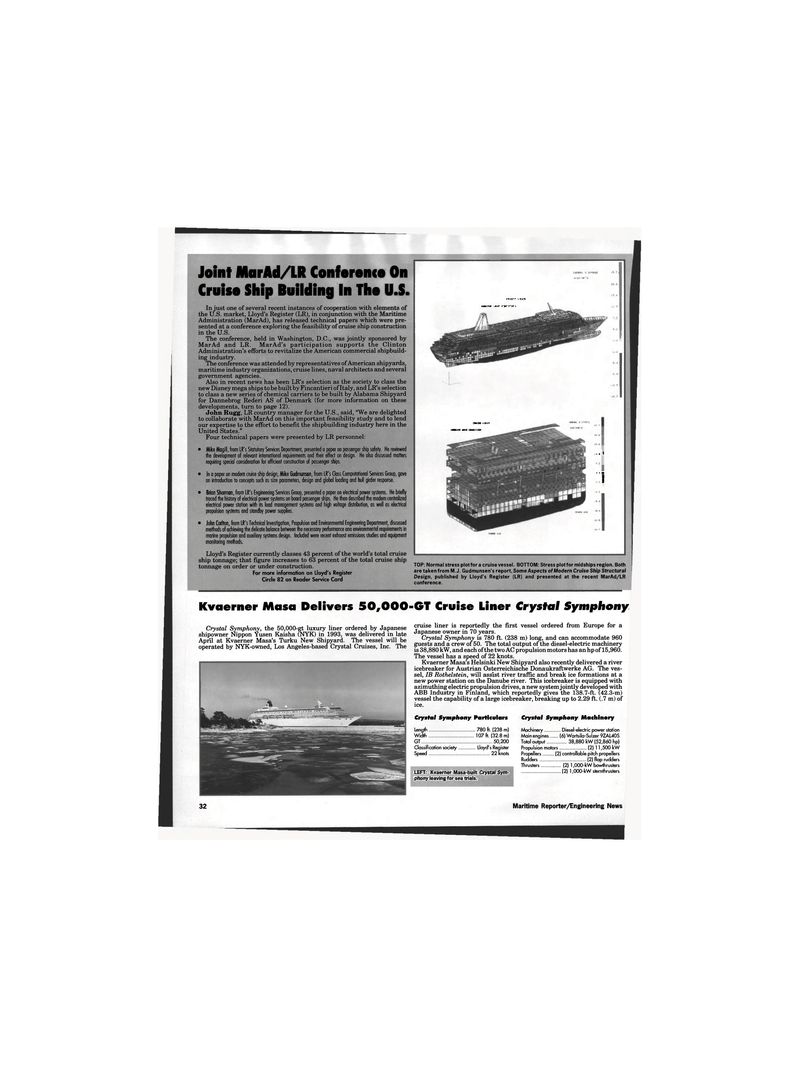
Page 30: of Maritime Reporter Magazine (June 1995)
Read this page in Pdf, Flash or Html5 edition of June 1995 Maritime Reporter Magazine
Joint MarAd/IR Conference On
Cruise Ship Building In The U.S.
In just one of several recent instances of cooperation with elements of the U.S. market, Lloyd's Register (LR), in conjunction with the Maritime
Administration (MarAd), has released technical papers which were pre- sented at a conference exploring the feasibility of cruise ship construction in the U.S.
The conference, held in Washington, D.C., was jointly sponsored by
MarAd and LR. MarAd's participation supports the Clinton
Administration's efforts to revitalize the American commercial shipbuild- ing industry.
The conference was attended by representatives of American shipyards, maritime industry organizations, cruise lines, naval architects and several government agencies.
Also in recent news has been LR's selection as the society to class the new Disney mega ships to be built by Fincantieri of Italy, and LR's selection to class a new series of chemical carriers to be built by Alabama Shipyard for Dannebrog Rederi AS of Denmark (for more information on these developments, turn to page 12).
John Rugg, LR country manager for the U.S., said, "We are delighted to collaborate with MarAd on this important feasibility study and to lend our expertise to the effort to benefit the shipbuilding industry here in the
United States."
Four technical papers were presented by LR personnel: • Mike Mngill, from LR's Statutory Services Deportment, presented a paper on passenger ship safety. He reviewed the development of relevant international requirements and their effect on design. He also discussed matters requiring special consideration for efficient construction of passenger ships. • In a paper on modern cruise ship design, Mike Gudmunsen, from LR's Class Computational Services Group, gave on introduction to concepts such as size parameters, design and global loading and hull girder response. • Brian Sharman, from LR's Engineering Services Group, presented a paper on electrical power systems. He briefly traced Hie history of electrical power systems on board passenger ships. He then described the modem centralized electrical power station with its load management systems and high voltage distribution, as well as electrical propulsion systems and standby power supplies. • John Carlton, from LR's Technical Investigation, Propulsion and Environmental Engineering Department, discussed methods of achieving the delicate balance between the necessary performance ana environmental requirements in marine propulsion and auxiliary systems design. Included were recent exhoust emissions studies and equipment monitoring methods.
Lloyd's Register currently classes 43 percent of the world's total cruise ship tonnage; that figure increases to 63 percent of the total cruise ship tonnage on order or under construction.
For more information on Lloyd's Register
Circle 82 on Reader Service Card r*-ifr i tier
K)M T-* eye 1'1*1 awrtf i •
MOsiw! «n( awcnic* .. i i.i m
I
TOP: Normal stress plot for a cruise vessel. BOTTOM: Stress plot for midships region. Both are taken from M.J. Gudmunsen's report, Some Aspects of Modern Cruise Ship Structural
Design, published by Lloyd's Register (LR) and presented at the recent MarAd/LR conference.
Kvaerner Masa Delivers 50,000-GT Cruise Liner Crystal Symphony
Crystal Symphony, the 50,000-gt luxury liner ordered by Japanese shipowner Nippon Yusen Kaisha (NYK) in 1993, was delivered in late
April at Kvaerner Masa's Turku New Shipyard. The vessel will be operated by NYK-owned, Los Angeles-based Crystal Cruises, Inc. The cruise liner is reportedly the first vessel ordered from Europe for a
Japanese owner in 70 years.
Crystal Symphony is 780 ft. (238 m) long, and can accommodate 960 guests and a crew of 50. The total output of the diesel-electric machinery is 38,880 kW, and each of the two AC propulsion motors has an hp of 15,960.
The vessel has a speed of 22 knots.
Kvaerner Masa's Helsinki New Shipyard also recently delivered a river icebreaker for Austrian Osterreichische Donaukraftwerke AG. The ves- sel, IB Rothelstein, will assist river traffic and break ice formations at a new power station on the Danube river. This icebreaker is equipped with azimuthing electric propulsion drives, a new system jointly developed with
ABB Industry in Finland, which reportedly gives the 138.7-ft. (42.3-m) vessel the capability of a large icebreaker, breaking up to 2.29 ft. (.7 m) of ice.
Crystal Symphony Particulars
Length 780 ft. (238 m)
Width 107 ft. (32.8 m)
GT 50,200
Classification society Lloyd's Register
Speed 22 knots
LEFT: Kvaerner Masa-built Crystal Sym- phony leaving for sea trials.
Crystal Symphony Machinery
Machinery Diesel-electric power station
Main engines (6) Wartsila-Sulzer 9ZAL40S
Total output 38,880 kW (52,860 hp)
Propulsion motors (2) 11,500 kW
Propellers (2) controllable pitch propellers
Rudders ) flap rudders
Thrusters (2) 1,000-kW bowthrusters (2) 1,000-kW stemthrusters 32 Maritime Reporter/Engineering News

 29
29

 31
31
